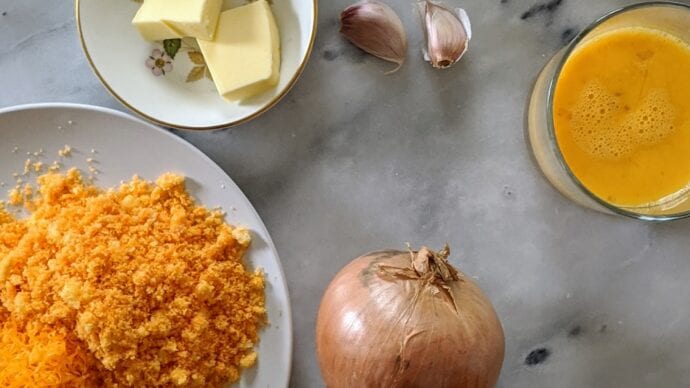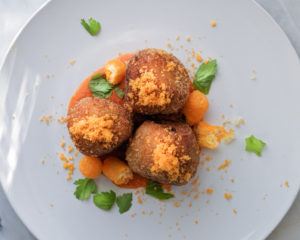This story is part of My Queer Kitchen with Jennifer E. Crawford: Pandemic Edition, a cooking series promoting community, ingenuity and delectability during the time of COVID-19.
Comfort food is as diverse as palates, genders and sexualities: We all have our own tastes, each with their own powerful histories and malleable meanings. In an ever-expanding universe, it’s hopeful to think our capacity for comfort is always growing, too. Taste buds are overlaid with thousands of olfactory memories from a zillion impressions and backdrops—a magnificent personal archive, a deliciously stacked library (heavy on the HQ classification), open all hours. A bite of familiarity is a time machine, transporting you through space and years to moments you felt comforted, nurtured, safe. It’s so incredibly specific; replicating mom’s tuna casserole is impossible (and for queers whose family isn’t welcoming, it might taste bitter no matter how heavy on the butter and cheese). But these little failures are their own reprieve: It’s a powerful gesture to know full well that the attempted recreation won’t be the same, but to continue in the hope that our culinary efforts might forge a new set of self-sustaining comforts, desires, even family.
So much of our collective day-to-day traumas right now remind me of when my PTSD was at its worst: The hypervigilance of surroundings, fearful of threat everywhere; the impossibility of leaving the house and the hopelessness that accompanies no defined end date. Queer communities are particularly vulnerable to this pandemic and already experience double the rates of PTSD diagnoses compared to straight people. Is a big bite of comfy, cheesy carbs really going to save us right now? I do know that a good roux and 1:1 ratio of milk and cheese have deliciously saved risky, scary days for me before, days that could have easily gone off the rails—or the wagon—had I not been so gratefully busy figuring out how to use up the stale Cheezies in my cupboard. Had that not kept me safe, how long might that bad string of days have lasted?
“Comfort is political: Who has the most access to it, how we create it for ourselves, how we create it for others.”
Comfort is political: Who has the most access to it, how we create it for ourselves, how we create it for others. As celebrities bemoan their confinement to multi-winged estates (in some cases comparing that decadence to jail), thousands of people are still heading into work, squaring up with the eye of the storm, so that others can have access to the comforts they’re accustomed to (toilet paper, food, medical care, garbage pickup and more). There’s no rest for the most essential. I hope to heck that after these heroic demonstrations of care, there will at least be a livable wage—another political measure of comfort long denied to the most deserving. To paraphrase Dolly Parton: Pour yourself a cup of cold ambition. They want you barely gettin’ by, all takin’ and no givin’.
I hadn’t thought much about the creation of self-comfort beyond how it applied to my shoes or mattresses. Before doing a treatment program for trauma at the Centre for Addiction and Mental Health (CAMH) in Toronto, I’d been all-consumed with my symptoms of hypervigilance and perfectionism—with survival. How do you build capacity for bearing the unbearable? I always thought that grit and resilience came from a gnashing of teeth, a bearing down and pushing forward, a NO DAYS OFF all-caps exuberance with Rocky yelling in my face “Keep moving forward!” no matter how fatigued I felt. Turns out it was much, much softer than that. Thank Gaga, because I was exhausted.
Where I thought fortitude came from applying myself to the wheels of the machine, grinding the grains of my humanity into flour (to be sold for someone else’s profit), I learned in that CAMH treatment program that it came instead from the permission to create measures of comfort, healing and rest that was equal to the traumas I had experienced. I made a cake each day during my first month in recovery. Like the dozens of culinary ratios in my head, with enough repetition, the recipe for healing became second nature. It is, thankfully, something my body can do intuitively now, as easily as how my eyes simply know what a cup of flour looks like. Learning how to create comfort for myself became the 1:1 measure I live by. Now, as my butter and cheese supplies are dwindling and mental health concerns rise around us in abundance, I think about this ratio of comfort and healing more and more.
There are queer comforts to be found in the pantry—self-created comforts that give us permission to be ourselves via their silliness, their unexpectedness or nourishing sense of humour. An ingredient may be past what common sense (and expiry dates) may call “their prime” but can still, with love and care, be coaxed into a delicious meal. Nothing is past saving, especially not you. Queer comfort food says: “Here, our feelings and desires can always be unapologetically as they are, no matter how extra.”
“Forging our own celebratory, lascivious, opulent comfort food out of very little is a radical act.”
I need to hear that message daily as much as anyone. In a world that insists on conformity to access its meagre cold comforts of tolerance, forging our own celebratory, lascivious, opulent comfort food out of very little is a radical act. Sharing those snacks with others makes the comfort even bigger, more powerful, more comforting. Queer comfort food isn’t a stuffy seated dinner: It’s an abundant buffet, a raucous dinner party, where you can take however much of what you love and leave the rest. Take a doggy bag if you like.
I’m just taking it one day, one meal at a time. I hope that this arancheezies recipe helps you find a point of entry for us to comfort ourselves together. We’re all experiencing this moment differently, so our comforts will surely differ. My measure for comfort to hardship is at minimum 1:1 and my palate is that of a six-year-old-meets-food-critic. I wonder what yours might be? Today is a good day for queer culinary comforts. It sets the stage with velvety, buoyant abandon for a hopeful future. I’d never tell you to smile right now, but to riff on Judy singing the wisdoms of Charlie Chaplin, “Snack, and there’ll be tomorrow.”
Arancheezies
These were born out of an abundance of rice, a lack of breadcrumbs (traditionally used in arancini) and a bag of stale Cheezies. I encourage you to make bold substitutions from your own pantry as you need!
Ingredients

1 cup arborio rice (or what you have! We used jasmine, because our queerantine pantry has a 20lb bag of it)
1 diced onion
2 minced cloves garlic
2 tbsp butter
4 cups stock
cup crushed Cheezies (and another 1 cup crushed Cheezies for rolling before frying)
½ cup finely shredded mozzarella
2 whisked eggs
1 ½ cup neutral oil (such as canola) for frying
Optional: 16 little cubes of cheese or fresh herbs for stuffing, sauce and herbs for plating
Method
- In a big pot, melt the butter then add the onions. Cook until translucent, then add the garlic and cook one minute more, until fragrant.
- Add the rice, then the 4 cups of stock. Cook for about 20 minutes. You’re literally overcooking the rice here, so that it will better stick together when forming and cooking the arancheezies. Give it a big stir, and cool the rice completely.
- Add the cup crushed Cheezies, eggs and shredded cheese to the cold rice and stir until evenly distributed.

- Roll into 16 evenly-sized balls. If stuffing with cheese or herbs, use your finger to make a little divot, insert the cheese and/or herbs, and reseal. Give each arancheezie a good little squeeze—it’ll help them stay together when you fry them. Refrigerate for at least an hour. While the arancheezies chill, you chill <333
- In a nice big pan, bring the oil up to medium-high heat. Set a plate lined with paper towels for draining next to your cooking area. Retrieve arancheezies from the fridge, and roll each of them in the additional 1 cup of crushed Cheezies. Fry a few at a time, being careful not to crowd the pan, until browned on all sides.
- Plate by putting a pool of sauce in the centre of a serving dish (tomato sauce, refried beans, guacamole, hummus, salsa—whatever you might have in your pantry that you think would taste good!). Place three arancheezies on the sauce. Garnish with crushed Cheezie dust, broken Cheezies and torn fresh herbs.



 Why you can trust Xtra
Why you can trust Xtra


